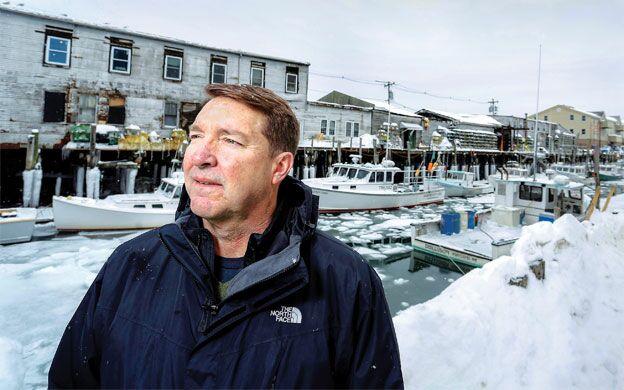What to do with an icon: Boston PR firm hired to retool branding for Maine lobster
 Photo / Tim Greenway
Matt Jacobson, executive director of Maine Lobster Marketing Collaborative, along the working waterfront in Portland.
Photo / Tim Greenway
Matt Jacobson, executive director of Maine Lobster Marketing Collaborative, along the working waterfront in Portland.
Delicious, healthy, sustainably harvested, traceable to individual fishermen rooted in fishing communities for generations.
This is the message around Maine lobster that has been promoted by marketing initiatives that have evolved over the years. Lobster harvesting is a $1 billion-a-year industry in Maine, but with an abundance of the marine crustacean the Maine Lobster Marketing Collaborative is looking for ways to develop new markets.
In December, the MLMC hired the global public relations firm Weber Shandwick to help expand existing markets and find new ones. Weber Shandwick will lead public relations, advertising, social media and digital content on lobsterfrommaine.com.
“We have a superhero in lobstermen, and a lot of brands don't,” says Patty Stone, executive vice president at Weber Shandwick in Boston. “We have this halo effect from Maine. You don't often walk into clients who have such built-in benefits.”
“We've got a great story to tell,” adds David Cousens, a fisherman and president of the Maine Lobstermen's Association. “We're poor at telling it, but we need to get better at it. We're independent businessmen, we catch the product, we bring it in fresh. It's a great, healthy, wild-caught product coming out of pristine water. We need to get that story out there because that story sells.”
Weber Shandwick's hiring follows a two-year period of turbulence and transition in the industry. In 2012, the market was glutted with lobster and the price paid to lobstermen hit a 30-year low. Even as other fisheries have struggled, lobster have been abundant. Many in the Maine lobster industry blame the poor market price on an increase in harvesting activity and an overabundance of processed product from Canada.
With the help of the state Department of Marine Resources, in 2013 the industry formed the Maine Lobster Marketing Collaborative to replace the previous Maine Lobster Promotion Council. The new collaborative, which was authorized by the state Legislature, included an increase in surcharges on licenses held by 6,000 lobstermen and 300 dealers and/or processors.
Changes included a greater commitment to marketing.
“Marketing is key,” says Cousens. “We fought like hell to get this marketing initiative going. Markets in Asia, right now, are increasing by 600% per quarter, which is unbelievable. So we're hopeful the live market will take off in the next couple of years.”
For the current year, the MLMC's total budget is $1.5 million, including $336,000 for administrative expenses and about $1.2 million earmarked for marketing, according to Executive Director Matt Jacobson. The marketing budget will provide up to $2 million annually through 2018.
At its peak in past years, the old collaborative had about $200,000 budgeted for marketing. So there's optimism that the larger marketing budget will pay off with a more contemporary branding message and greater sales.
Shipping live lobster long distances can be a challenge due to its cyclical molting process, which means for part of the year it has a soft shell. The lobstermen's association is researching ways to get around this.
“We need to supply the market where it's strong,” Cousens says. “China is where it's at. To get there, the lobster needs a good shell on it. If we can make a dent in that market, that's good for us.”
Working from Boston, Weber Shandwick offers neighborly familiarity with Maine culture combined with abundant resources and global exposure, says Stone.
Of the staff, “we have a number of folks who are from Maine, who have family in the lobstering industry,” Stone says, adding the firm has worked with another iconic Maine brand, L.L.Bean. “So we're familiar with the world of Maine and with the authenticity of Maine.”
New lobster marketing is still in the planning stage. But Stone cites the firm's work with the DeWitt, Mich.-based Cherry Marketing Institute, which promotes tart cherries, at one time known only as a pie ingredient. Weber Shandwick repositioned it as a contemporary “super fruit,” with year-round availability and potential nutrition benefits.
Weber Shandwick worked with growers, handlers and processors to address target audiences, including decision-makers at food manufacturing and food-service companies. The firm's marketing strategy “delivered a steady stream of broad-reaching national exposure in consumer food, nutrition and lifestyle media,” says Stone. “The industry has also seen increased new product introductions featuring tart cherries as an ingredient, as well as double-digit increases in tart cherry menu mentions.”
The strategy has “real synergy” with Maine lobster, she says.
Weber Shandwick will work with the MLMC's Jacobson and board members. It is also redeveloping the website, auditing social media and reviewing the brand, culture and competition.
“We're looking at a multi-year campaign, and determining and defining what our targets are for this year, and each year spreading it out,” Stone says. At the moment, the focus is on the Northeast and on restaurants as large-quantity buyers. By 2016, she says, they'll be ready to step up outreach on a global scale.
One challenge to fix, says Jacobson, is the lack of domestic data about where lobster is sold and consumed, due to a supply chain that begins at the dock and potentially goes through multiple dealers and processors — each with their own customer list, sometimes ending up in Canada for processing and then returning as Canadian product.
“It's hard to tease out the numbers,” Jacobson says. “We're working with Weber Shandwick on the data problem.”
A recently completed menu survey by Chicago-based Technomic Inc., a food-industry research firm, determined that West Coast restaurants are a strong market for Maine lobster. “That goes back to the question of, 'Where are our markets?'” Jacobson says. “If California consumers demand Maine lobster and will pay a premium, suppliers will supply it.”
Storytelling will have a big part in selling the product, Stone says. “We'll be looking at lobstermen as our spokespeople and working with them to have them broadcast the message,” she says. “They are the storytellers. It's their livelihood.”
Says Jacobson, “We'll focus on people in the industry and what they do and how they do it — the sustainability that's built into our laws, the solitary nature of fishing, doing everything by hand, a traditional industry that families pass down through generations. The iconic Maine fishing village. We'll tell those stories. Look at what moves the needle in the food market: People are looking for local, for authentic. They want to know where they food came from. We have incredible stories around that.”
Read more










Comments